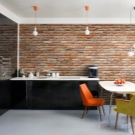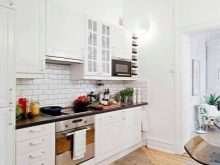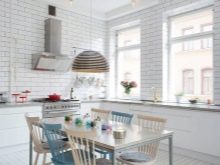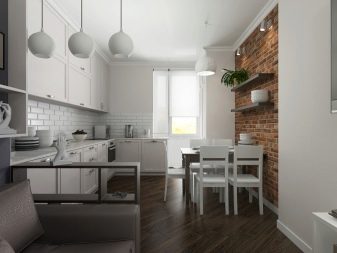Not so long ago, walls with embossed patterns came into fashion: thick layers of paints, voluminous figures and a brick wall. Yes, she won the hearts of a large number of people - many, inspired, began to use this form of giving originality to their kitchen. Then, brick-made wallpapers came to the aid of designers, which create an atmosphere of comfort, a warm fireplace and European traditions.






Why do we need such wallpaper?
At all times, people have sought to secure their housing and feel protected. Not for nothing in society there is such a phrase: "My home is my fortress." It gives a person confidence that you can relax in your home and not worry about sudden changes that bring any undesirable consequences.
And what can give a person such confidence, if not the design of the room and the external picture of where he lives. Therefore, many, recalling the cozy atmosphere of past centuries, gave their preference to walls in the form of brickwork.
It looks quite interesting, primitive, but ideally fits the modern furniture of the room, complementing its bold design image with its appearance.




Typically, brick walls are made in the kitchen. Many owners were satisfied with the result and noted that because of the appearance of such a finish, a special atmosphere is created that is inherent in the “heart of the house”. It’s nice to come and cook in such a room. Indeed, kitchens with a brick wall compare favorably with kitchens with familiar wallpapers familiar from the time of the USSR. Now any room can be turned into a Gothic palace or a modern room in the style of minimalism.
Such options look quite interesting in apartments with a small area, being almost the only opportunity to create original images in a limited area.



Kinds
Using masonry wallpapers can be a huge number of options. There is an incredible variety of shades of brick that look good in the interior of the kitchen, ranging from white to dark brick. But not only their differences end there, it can be the quality of the material from which the wallpaper is made, the number of “bricks”, their severity among the main background - “cement”. Equally important is the price of the finished option.
Below are the popular types of such coatings and their brief description is given.
- Paper - One of the economical options, are familiar to all the usual "stickers" on a soft basis. Small bulges in the form of brickwork create the desired image.
They also combine environmental friendliness, unlike other materials, without representing any danger affecting people's health.

- Vinyl Combine high quality and special resemblance with their true “brothers”. They completely imitate a brick with all its roughnesses, roughnesses, bends. A huge plus of this type is that the wallpaper protects the room from external influences - be it scuffs, tears or spots. Vinyl perfectly “transfers” moisture, dampness, therefore it will look especially good in basements with a lack of natural light.
Sudden changes in temperature do not harm vinyl, which extols this material over other variations of wall pasting. Most often it is used as decoration for hallways, bathtubs and kitchens - places where various types of pollution are most common.


- Non-woven most popular are between paper and vinyl. Their quality cannot be called the best, but this option is quite suitable for pasting the kitchen. The non-woven fabric creates an image of masonry, adheres well to the wall, so it does not create special problems during repair.


Which to choose?
Having studied the main types of wallpaper and the material from which they are created, you should proceed to the next step - the choice of wall covering in accordance with factors such as price / quality.
- The cheapest option is undoubtedly paper. Their cost rarely goes beyond ordinary coatings with soft bulges. The main disadvantage is that because of them, a separate part of the house can acquire a dull and unattractive appearance. But you should pay attention to the fact that paper is suitable only for dry rooms and rooms without constant sharp changes in temperature.
The logical conclusion immediately comes from the foregoing - this is not the best option for the kitchen. This type should be protected from scuffs, sharp cutting objects and dampness. The disadvantages can also be attributed to the fact that they do not fully reproduce the masonry for which the image was created.


- The average cost of interlining varies from 700 rubles per meter (2019). The coatings are suitable for the kitchen and room, but they should be used with care in the hallway. Such wallpapers are able to "survive" moisture, washing.
The only drawback is that an air gap forms between the wall and the non-woven, which contributes to the formation of mold in this place.

- Vinyls are not afraid of many factors that can damage their appearance. But their main disadvantage is the high price. They are mainly used where people do not live, since non-woven fabric does not let air through, which can adversely affect the health of people and animals living in the house.

Wallpaper color
In color, they differ and represent an infinite number of variations - from solid shades to color changes almost every half meter. In order to refresh the kitchen, designers often choose wallpaper under a white brick. They combine well with the "metallic" color of kitchen furniture and utensils for cooking. Solid colors also look good bright items and household items that have saturated colors.



In the interior, light brick usually leave as much free space as possible. Thus, the appearance of a large area and a special cosiness is created. Therefore, designers have developed a rule: the smaller the room, the brighter it should be.
It should be borne in mind that in good lighting, all irregularities or damage to the vertical surface are perfectly visible. This may distort the previous idea, so when choosing an option, it is worth taking high-quality ones with a voluminous pattern. Non-woven and vinyl surfaces meet these requirements.
In dark places, on the contrary, smooth options are used. In this case, paper or non-woven wallpaper is suitable.


Another type of brick is red. She is the most popular among all the rest. This is facilitated by the fact that, unlike white, it is not very dirty and resembles a real masonry.
But for lovers of diversity, there is also a solution - Those who planned to glue the room in white can decorate red corners, arches and sections of walls where large objects are located. With this solution, the room is completely changing and transforming. In the same way, the problem of unevenness of the room is solved.



Masonry drawing
Bricks are inherently different in size. They can be in the form of small pebbles, large rectangles or squares. They also differ in the degree of “scuffs” - new polished or old, with “defects” and broken edges. It all depends on the design idea and the interior of the room. Someone chooses a new coating, and someone is content with the "old" if it fits into an idea that resembles, for example, the Gothic style.



Voluminous “stones” look much more natural than their smooth “brothers”. They attract more attention, reproduce the imitation of masonry, thus creating the appearance as if the wall was truly made of brick. There are also various surfaces with a matte and glossy finish.
They should be used in small dark rooms or rooms that do not focus on wallpaper.


disadvantages
No matter how good the wallpaper and the master who pasted them are, but they are not real bricks. When using this finish in the kitchen, all joins become visible. therefore designers they do not recommend directing artificial light on such wallpapers, positioning the chandelier exactly in the middle and avoiding lighting on the sides. Finishing on one or several walls opposite to each other will look good. In such cases voluminous furniture will be just in time.
Covering a part of the wall with itself, it visually distracts the attention of the viewer from all the shortcomings of the artificial finish, and the delimitation allows you to determine the places for the rest of the necessary household items: refrigerator, washer, drawer for dishes, table.


In small kitchens, it is not at all necessary to comply with this rule, since most of the objects are loaded on each other, and the room does not have enough space in order to find a place for them. Red brick on the background of the main color helps to diversify the interior and distract the eye from possible visible flaws.
The main thing is that the shades are neutral, otherwise the riot of colors will only distract attention. The ideal option is a combination of brickwork with natural shades in the interior.


See how to make an imitation of a brick wall in the interior in the next video.










